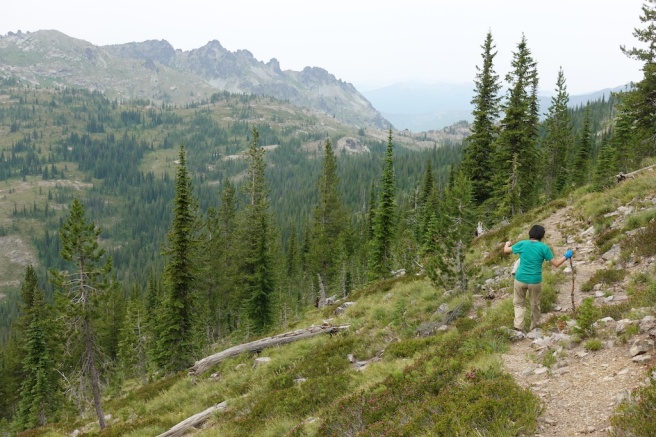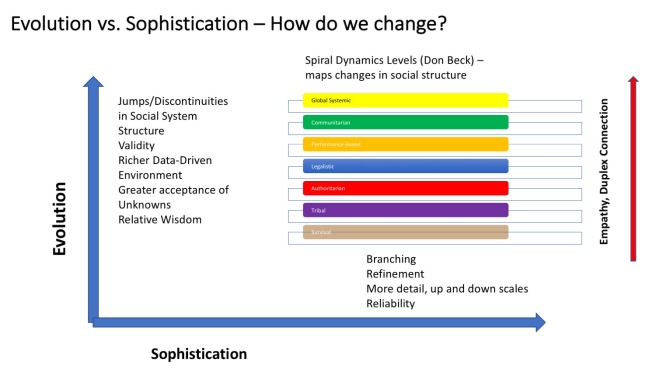
The first middle-age Taiwanese psychologist to see the Kelly Creek Hoodoos, Clearwater NF, Idaho, August, 2018
One of the things I’ve been thinking a lot about recently is empathy, its various stages, and larger social coherence. It’s easy to state something like “empathy is the key thing that creates social coherence.” But the truth is more complex, and in the end, the connecting dynamic of empathy and how it actually manifests is really just what it is — an understructure for assuming that everyone in the larger collective is operating on the same v-Meme page. Societies are like any other living thing. They attempt to maintain homeostasis through the various means, memes and dynamics available to them. Low empathy societies can have broad scale social coherence — there’s something like 1.2 billion people in China, and few would argue that it is still, after 2000 years of change and progression, an Authoritarian culture, with Legalistic intentions.
Yet Chinese people get things done in groups. One of my favorite stories from the ’90s, before the incredible technical/social surge in China, came from a friend of mine who was, at the time, working for a large petrochemical concern in northwest Washington State. A process engineer, he was tasked with going to China to figure out a deal between his company and the Chinese state for them to co-own and supervise that oil refinery.
The first thing that hit him was the total employment at the refinery — around 15,000 people. This for a refinery that produced about half the output (I think — memory fades here a bit) of their super-connected facility stateside. What did all those people do? If you needed a big hole dug, the supervisor would issue the order — to 1000 people with shovels. They would run over to the place where the hole needed to be dug, and people would start digging.
For such a hole to be dug stateside, my friend would schedule one of the front end loaders on the sheet, the operator would go out there perhaps with a surveyor and a supervisor, and the hole would be dug. When he asked his plant engineer cohort why they hadn’t bought a large piece of earthmoving equipment (this is the 1990s, not the 1890s!) he said “well, what would all those people do if they couldn’t dig that hole?” My friend’s company did not end up buying the refinery.
Needless to say, there is large-scale social coherence needed to have 1000 people dig a hole at once, and perhaps there are lessons to be learned as well. How can we understand this? Societies are seldom static, and at some level, many of the cultures that exist in the world today have lots of stuff to teach any person. But at the same time, the information must be contextualized in order to be understood. Do we really need to understand how to get 1000 people to dig a hole in this day and age?
Let’s start with one of my favorite pictures — the Evolution vs. Sophistication map, that shows a 2-d landscape for understanding complexity of knowledge. See below:

Something like the 1000 people digging a hole at once requires a fair amount of sophistication, but assumes lots of homogeneity in the folks digging the hole. China is one of the least diverse countries, considering its gross population, on the planet — some 95% of the population is Han Chinese. So we can assume that there is very little differentiation among the individual workers digging the hole. They need short spatial scales, and short temporal scales in order to coordinate the digging. All you really need to know is the direction you’re supposed to be going, and how to dig so you don’t hit your neighbor’s shovel. Not a lot of agency is required, and in fact, would be punished. Someone doing something radically different would likely mess up the larger group coordination.
Energetics of individual nodes/workers are pretty much the same. There might be a couple of high-flyers out there digging ahead of the rest of the crew, but they’re fed the same egg-and-rice caloric input everyone else is fed. You’re supposed to watch the leader (who, being Han Chinese as well) looks like you, and in case you, dear reader, have never dug a ditch, trust me that there’s not a lot of brain power required. But in a world of work scarcity, everyone is assured their place. They’re out of the Survival v-Meme.
If you had to locate the whole operation on the graph above, you’d map out from the Authoritarian v-Meme (workers are told where to dig) about 25%. It’s a simple task, and the knowledge structures are authority-driven fragments (Dig here! Start digging! Stop digging! Time for lunch!) There is likely higher level coordination up a couple of levels. Someone has to decide that the hole needs to be dug. But even that position has to be relatively low empathy. You can’t really be worried about 1000 workers with shovels, other than to make sure they’re directed, and fed.
As we’ve discussed earlier in this blog, just because a society is low-empathy doesn’t mean it doesn’t continue to aggregate knowledge in the knowledge structures that are available to it. The Chinese have been doing this for literally thousands of years, and in many ways, when it comes to sophistication of managing social coherence, are way ahead of us. I’ve written here about The 36 Stratagems, which are how one deals with one’s competitors, as well as here about Chengyu, which are often ways one deals with the empathy-disordered in the midst. Over a couple thousand years, it does no good to deny that there are psychopaths in your midst. If you want larger social coherence, you have to provide mechanisms for people to acknowledge the validity of one’s authority. And it has to be in the knowledge structure that people can use. Hence, the 4 and 8 character chengyu, narrative tags for larger stories, that number in the thousands and pull deeper Tribal v-Meme knowledge up that allow people to accept the reality of living with various, controlling assholes and not losing their minds. If one were to plot that on the graph above, I think it’s safe to say we’re out around 95% from the Authoritarian v-Meme. Considering the difficulty we’re having in dealing with the empathy-disordered, or even acknowledging their existence, across politics, corporate leadership, or even in our own backyard, we sure could use some social coherence learned from the Chinese about now.
It’s fun to talk about the lower v-Memes with regards to social coherence, because the short timescales are something we can relate to. In fully Tribal v-Meme societies, the way social coherence is maintained is, too often, killing someone who’s causing problems, or coming up with an appropriate compensation strategy for the victim. Jared Diamond talks extensively about this in Guns, Germs and Steel. When someone is giving you a hard time you didn’t deserve at work, certain brief strategies have to cross your mind!
As one moves up the Evolution axis, it simply makes sense that as agency increases, developed empathy has to also increase. We’ve got to consider someone’s emotions, as well as outcomes they might want to achieve, in order to reach social coherence. For the Legalistic v-Meme, this gets embodied in everyone following the same regulations, or even standards and codes, if you want to think like an engineer. When you screw a nut onto a bolt, you expect it to be manufactured within a specification so you can spin it tight.
But all this requires more information, structured appropriately. A general use bolt comes with implied characteristics, and maybe the only thing that matters is the thread size, bolt length, and such. But move out much of the Sophistication axis, for varying applications (like high temperature, corrosive environments, etc.) and you’re into some serious algorithmic process restriction.
Up the Spiral, to Performance v-Meme behavior, shared goals, scaffolded from below, provide coherence. On up into Communitarian v-Meme behavior, the example that comes to mind that sounds trivial, but in reality is quite complex, might be the ritual of the Potluck dinner. Everyone in the community has to have data on each other’s masterful dish, and when those independent nodes communicate, the group can show up in one place with a memorable feast. Trust and empathy naturally come into it — one has very little leverage except the value of the independently generated relationship. And you’ve got to know if Susie or Hans is lying about buying that new super-duper deep fat fryer. The proof will be in the fried chicken. Imagine an Authoritarian potluck, with no sophistication. One person tells all the members what to bring, regardless of their capability. Feedback comes back only after the experience itself. Not so great for everyone having a savory time.
In the end, social coherence, or the homeostasis that marks its existence, is maintained in any social circumstance through that integral feedback loop of knowledge structure, social structure, empathetic development, and independent agency. It’s an interminable chicken-and-egg process. Change one, and it does feed back to the others — but not necessarily the way one thinks. Give complex, sequenced commands to a bunch of Authoritarians, through yelling at them (or standing up in front of a classroom) well, don’t expect too much. If the chaos is high enough, and the social coherence a priori is weak, you can expect a little Tribal v-Meme In-group/Out-group dynamic. Don’t be surprised when you’re the one driven into the wilderness.
But once you understand its need, the one thing that almost always will yield positive benefits is growing your people empathetically. It’s always easy to reach down and get in the ditch. Not so easy to reach upward in an immediate circumstance.
Something that amazes me (as a person who’s never worked for a company with more than about 100 people in it) is how large companies get things done. Microsoft for example has over 130,000 employees to make a few hundred different products, and brings in 110 B in revenue. Emergent behavior at work!
LikeLike
One of the other things that is interesting (and I’ve done a lot of thinking about) is how large companies, composed of lots of lower v-Meme individuals, generates higher v-Meme behavior. Emergence is the answer — Boeing is in aggregate a Global Systemic v-Meme enterprise. Likely because of the global influence of 100 people dying at once in a plane crash.
LikeLike
You might find interesting a book by Brian J. McVeigh, The “Other” Psychology of Julian Jaynes.
In Chapter 4, he discusses ancient China and the kind of social order and mentality that developed, remaining in place into the modern era. It’s the section on post-bicamerality that I had in mind (pp. 71-3 in the printed book). Also, Chapter 5 is “The Metaphors of Mind-Words in Modern Mandarin”, maybe of interest as well.
You can read some of it for free in Google Books.
LikeLike
I’ll look it up, Benjamin. Thanks!
LikeLike